 W
W010 Editor is a commercial hex editor and text editor for Microsoft Windows, Linux and macOS. Typically 010 Editor is used to edit text files, binary files, hard drives, processes, tagged data, source code, shell scripts, log files, etc. A large variety of binary data formats can be edited through the use of Binary Templates.
 W
WAndroid Studio is the official integrated development environment (IDE) for Google's Android operating system, built on JetBrains' IntelliJ IDEA software and designed specifically for Android development. It is available for download on Windows, macOS and Linux based operating systems or as a subscription-based service in 2020. It is a replacement for the Eclipse Android Development Tools (E-ADT) as the primary IDE for native Android application development.
 W
WBlueJ is an integrated development environment (IDE) for the Java programming language, developed mainly for educational purposes, but also suitable for small-scale software development. It runs with the help of JDK.
 W
WCheat Engine (CE) is a free and open-source memory scanner/debugger created by Eric Heijnen for the Windows operating system. Cheat Engine is mostly used for cheating in computer games and is sometimes modified and recompiled to evade detection. The program resembles L. Spiro's Memory Hacking Software, TSearch, and ArtMoney. It searches for values input by the user with a wide variety of options that allow the user to find and sort through the computer's memory. Cheat Engine can also create standalone trainers that can operate independently of Cheat Engine, often found on user forums or at the request of another user.
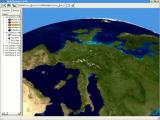 W
WEarth3D was developed as part of a diploma thesis of Dominique Andre Gunia at Braunschweig University of Technology to display a virtual globe of the earth. It was developed before Google bought Keyhole, Inc and changed their product into Google Earth. Earth3D downloads its data from a server while the user navigates around. The data itself is saved in a Quadtree. It uses data from NASA, USGS, the CIA and the city of Osnabrück.
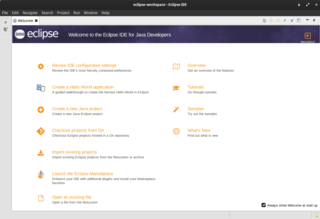 W
WEclipse is an integrated development environment (IDE) used in computer programming. It contains a base workspace and an extensible plug-in system for customizing the environment. Eclipse is written mostly in Java and its primary use is for developing Java applications, but it may also be used to develop applications in other programming languages via plug-ins, including Ada, ABAP, C, C++, C#, Clojure, COBOL, D, Erlang, Fortran, Groovy, Haskell, JavaScript, Julia, Lasso, Lua, NATURAL, Perl, PHP, Prolog, Python, R, Ruby, Rust, Scala, and Scheme. It can also be used to develop documents with LaTeX and packages for the software Mathematica. Development environments include the Eclipse Java development tools (JDT) for Java and Scala, Eclipse CDT for C/C++, and Eclipse PDT for PHP, among others.
 W
WEclipse Che is an open-source, Java-based developer workspace server and Online IDE. It includes a multi-user remote development platform. The workspace server comes with a flexible RESTful webservice. It also contains a SDK for creating plug-ins for languages, frameworks or tools. Eclipse Che is an Eclipse Cloud Development (ECD) top-level project, allowing contributions from the user community.
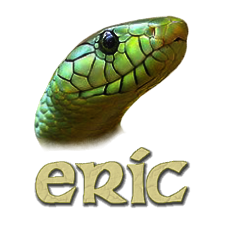 W
Weric is a free integrated development environment (IDE) used for computer programming. Since it is a full featured IDE, it provides by default all necessary tools needed for the writing of code and for the professional management of a software project.
 W
WFASM is an assembler for x86 processors. It supports Intel-style assembly language on the IA-32 and x86-64 computer architectures. It claims high speed, size optimizations, operating system (OS) portability, and macro abilities. It is a low-level assembler and intentionally uses very few command-line options. It is free and open-source software.
 W
WfpGUI, the Free Pascal GUI toolkit, is a cross-platform graphical user interface toolkit developed by Graeme Geldenhuys. fpGUI is open source and free software, licensed under a Modified LGPL license. The toolkit has been implemented using the Free Pascal compiler, meaning it is written in the Object Pascal language.
 W
WFree Pascal Compiler (FPC) is a compiler for the closely related programming-language dialects Pascal and Object Pascal. It is free software released under the GNU General Public License, with exception clauses that allow static linking against its runtime libraries and packages for any purpose in combination with any other software license.
 W
WFreeBASIC is a multiplatform, free/open source (GPL) BASIC programming language and compiler for Microsoft Windows, protected-mode MS-DOS, Linux, FreeBSD and Xbox. The Xbox version is no longer maintained.
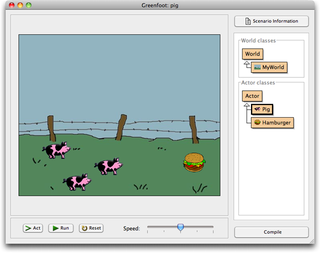 W
WGreenfoot is an integrated development environment using Java or Stride designed primarily for educational purposes at the high school and undergraduate level. It allows easy development of two-dimensional graphical applications, such as simulations and interactive games.
 W
WHamilton C shell is a clone of the Unix C shell and utilities for Microsoft Windows created by Nicole Hamilton at Hamilton Laboratories as a completely original work, not based on any prior code. It was first released on OS/2 on December 12, 1988 and on Windows NT in July 1992. The OS/2 version was discontinued in 2003 but the Windows version continues to be actively supported.
 W
WHollywood is a commercially distributed programming language developed by Andreas Falkenhahn which mainly focuses on the creation of multimedia-oriented applications. Hollywood is available for AmigaOS, MorphOS, WarpOS, AROS, Windows, macOS, Linux, Android, and iOS. Hollywood has an inbuilt cross compiler that can automatically save executables for all platforms supported by the software. The generated executables are completely stand-alone and do not have any external dependencies, so they can also be started from a USB flash drive. An optional add-on also allows users to compile projects into APK files.
 W
WFlexHex is a freeware hex editor for Microsoft Windows that can edit files, NTFS alternate streams and sparse data, OLE compound files, logical disks, and physical drives.
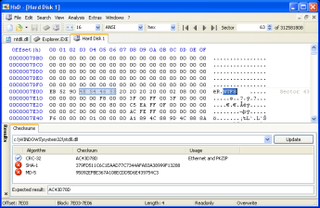 W
WHxD is a hex editor, disk editor, and memory editor developed by Maël Hörz for Windows. It can open files larger than 4 GiB and open and edit the raw contents of disk drives, as well as display and edit the memory used by running processes. Among other features, it can calculate various checksums, compare files, or shred files.
 W
WLazarus is a free cross-platform visual integrated development environment (IDE) for rapid application development (RAD) using the Free Pascal compiler. Its goal is to provide an easy-to-use development environment for programmers developing with the Object Pascal language, which is as close as possible to Delphi.
 W
WMicrosoft XNA is a freeware set of tools with a managed runtime environment that Microsoft developed to facilitate video game development. XNA is based on .NET Framework, with versions that run on Windows and Xbox 360. XNA Game Studio can help develop XNA games. The XNA toolset was announced on March 24, 2004, at the Game Developers Conference in San Jose, California. A first Community Technology Preview of XNA Build was released on March 14, 2006.
 W
WNASA WorldWind is an open-source virtual globe. It was first developed by NASA in 2003 for use on personal computers and then further developed in concert with the open source community since 2004. As of 2017, a web-based version of WorldWind is available online. An Android version is also available.
 W
WNetBeans is an integrated development environment (IDE) for Java. NetBeans allows applications to be developed from a set of modular software components called modules. NetBeans runs on Windows, macOS, Linux and Solaris. In addition to Java development, it has extensions for other languages like PHP, C, C++, HTML5, and JavaScript. Applications based on NetBeans, including the NetBeans IDE, can be extended by third party developers.
 W
WThe Netwide Assembler (NASM) is an assembler and disassembler for the Intel x86 architecture. It can be used to write 16-bit, 32-bit (IA-32) and 64-bit (x86-64) programs. NASM is considered to be one of the most popular assemblers for Linux.
 W
WPhysX is an open-source realtime physics engine middleware SDK developed by Nvidia as a part of Nvidia GameWorks software suite.
 W
WQB64 is a self-hosting BASIC compiler for Microsoft Windows, Linux and Mac OS X, designed to be compatible with Microsoft QBasic and QuickBASIC. QB64 is a C++ emitter, which is integrated with a C++ compiler to provide compilation via C++ code and GCC optimization.
 W
WQP is a family of lightweight, open source software frameworks for building responsive and modular real-time embedded applications as systems of cooperating, event-driven active objects (actors).
 W
WResource Hacker is a free resource extraction utility and resource compiler for Windows developed by Angus Johnson. It can be used to add, modify or replace most resources within Windows binaries including strings, images, dialogs, menus, VersionInfo and Manifest resources. It can also create resource files (*.res) from scratch and the latest release provides a number of text templates to facilitate this.
 W
WSilverfrost FTN95: Fortran for Windows is a Fortran compiler for Microsoft Windows. It generates code for native IA-32 Win32, x86-64 and for Microsoft's .NET platform. FTN95 comes in three licensed editions: Commercial, Academic and Personal. The Personal edition is free and is designed for personal use. Programs written with the Personal edition show a banner for a short time when they are run.
 W
Wvisage|SDK is a multiplatform software development kit (SDK) created by Visage Technologies AB. visage|SDK allows software programmers to build a wide variety of face and head tracking and eye tracking applications for various operating systems, mobile and tablet environments, and embedded systems, using computer vision and machine learning algorithms.
 W
WVisual Prolog, formerly known as PDC Prolog and Turbo Prolog, is a strongly typed object-oriented extension of Prolog. As Turbo Prolog, it was marketed by Borland but it is now developed and marketed by the Danish firm Prolog Development Center (PDC) that originally developed it. Visual Prolog can build Microsoft Windows GUI-applications, console applications, DLLs, and CGI-programs. It can also link to COM components and to databases by means of ODBC.
 W
WThe Xojo programming environment and programming language is developed and commercially marketed by Xojo, Inc. of Austin, Texas for software development targeting macOS, Microsoft Windows, Linux, iOS, the Web and Raspberry Pi. Xojo uses a proprietary object-oriented language.